about the Aaron Burr Society

The Aaron Burr Society is dedicated to exposing the myths of Free Markets and Free Trade while challenging the integrity of Wall Street and their corporate cronies. The Society is an absurdist, conceptual artwork operating in the public sphere, building on the revolutionary traditions of the Early Modernists, Situationalist and Fluxus movements. We are rewriting history and mythology from an Enlightened Progressive perspective. However, though we are absurdist in nature, we take great pride in the accuracy of the information that we present to The People. Our goal is a progressive, sustainable re-imagining of the American Dream to be achieved by promoting a renaissance of the Enlightenment: the secular humanist principles of the American and French Revolutions—the first revolutions for universal human rights.
The Aaron Burr Society’s artworks are not metaphorical but symbolic in form and function. By this we mean that it is not like or as a revolution but we are consciously attempting to make the signs and symbols for a rebellion against Wall Street and their corporate cronies, especially those in the oil and coal industries. We do this knowing that a progressive, non-violent revolution is necessary to save our planet and its people. We cannot create a sustainable environment without economic and social justice based on internationally recognized standards of Fair Trade and a Living Wage.
The origins of the Society can be traced to the artist collective REPOhistory. The collective’s strategy was to create site-specific, public artworks that dealt with issues of class, race, gender and sexuality. In 1992 REPOhistory launched its inaugural public artwork titled the Lower Manhattan Sign Project, our contribution was a sign placed in front of the New York Stock Exchange titled The Advantages of an Unregulated Free Market Society. The back of the sign stated that government deregulation and Wall Street fraud were responsible for the every major economic crash since the 1890s. The president of the Stock Exchange unsuccessfully tried to have the sign taken down but never questioned its accuracy.




















